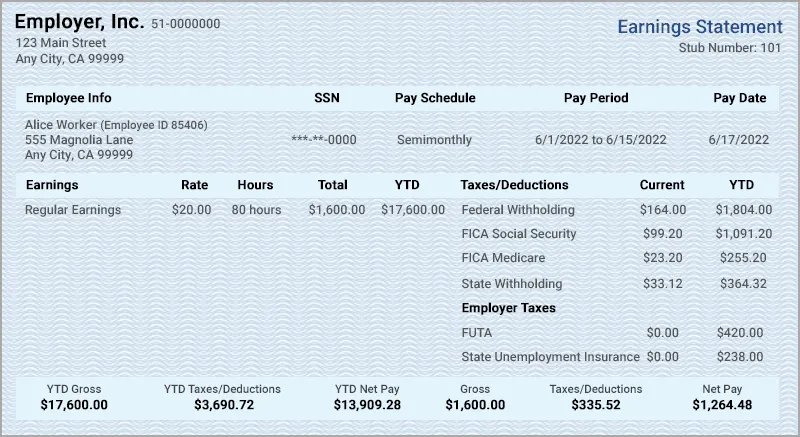How to Make Sense of Your Pay Stub
Quick Answer
Your pay stub can be a confusing document, but it contains a wealth of information about deductions for things like taxes, insurance and retirement benefits.

Are you wondering why you earned $1,600 but only received a paycheck for $1,264.48? Your pay stub or earnings statement can help you understand how much you were paid and how much was withheld or deducted for taxes, insurance and other employee benefits.
Your pay stub can help you unlock the mystery of how the hours you work translate to the money you take home. You can use your pay stub to check the accuracy of your hourly wage or salary, the number of hours you worked, what you are paying in taxes, your contribution to retirement or health savings and garnishments taken out of your pay. You may also use your pay stub to prove your income on a credit application.
What's on a Pay Stub?
Your pay stub shows a wide range of information on pay and deductions. We'll dive into more details in a moment, but the basic information on your pay stub generally includes:
- Pay period
- Hourly pay rate
- Hours worked, if you're paid hourly
- Gross wages for the current period and year-to-date (YTD)
- Federal, state and local income taxes paid from your paycheck
- Federal Insurance Contributions Act (FICA) contributions to Social Security and Medicare insurance
- Net pay, or how much you receive after deductions are subtracted from your gross wages
Your pay stub may also include deductions your employer has taken for your share of health insurance premiums, 401(k) contributions and any wages you've had garnished. (Wage garnishment can occur if you owe back child support payments court order, for example.) Your pay stub may also list a running tally of accrued hours that you can use for paid time off (PTO) or sick time.

Where Do You Find Your Pay Stub?
If you receive a paper paycheck, your pay stub likely comes attached to it when it's issued to you. If you receive your pay by direct deposit, your employer may email an earnings statement to you or make these statements available via a secure website, which you'll access with a login and password.
Employers aren't required to provide pay stubs in every state. Alabama, Arkansas, Florida, Georgia, Louisiana, Mississippi, Ohio, South Dakota and Tennessee have no pay stub requirement for employers, though employers can still provide them for their employees' benefit. Other states have varying regulations, which may allow electronic or paper statements, printed statements only, opt-ins and opt-outs, and periodic statements instead of documentation with every paycheck.
Even if your employer isn't required to provide pay stubs, you can request earnings information from them. The federal Fair Labor Standards Act requires employers nationwide to maintain payroll information that includes identifying information, hours worked, wages paid and itemized deductions.
What Are Gross vs. Net Wages?
A common point of confusion is gross versus net wages. Your pay stub shows both. What's the difference?
- Gross wages are your pretax earnings. You can double-check the math on your salary by dividing your expected annual salary by 12 if you're paid monthly, by 24 if you're paid twice a month or by 26 if you're paid every two weeks. If you're paid hourly, multiply the number of hours in the pay period by your expected wage, double-checking that your paid hours are the same as the hours you actually worked.
- Net wages are the earnings you actually take home. Your net wages are your gross wages minus federal, state and local taxes; Social Security and Medicare insurance payments; health savings account (HSA), flexible spending account (FSA) and retirement plan contributions; any payments you make for benefits (such as health insurance); court-ordered garnishments; and voluntary deductions such as automatic savings.
If you're applying for a mortgage loan, credit card or rental property, you may be asked to provide a copy of your most recent pay stub as proof of your gross income. Your net wages are the number you should use when you're budgeting, however, since it accurately reflects the money you bring home as pay.
What Are Paycheck Deductions?
Although the list of payroll deductions is long, some of the most common are listed below, along with typical abbreviations that might appear on your pay stub. If you see a deduction on your paycheck that you don't recognize, ask your employer to explain it to you.
| Abbreviation | What It Means |
|---|---|
| FED, FIT, FITW, FWT | Federal income tax withholding, based on your W-4 |
| DEN | Dental insurance benefit payment |
| FICA | Social Security and Medicare insurance |
| FICA/MT or FIM | Medicare insurance |
| FICA/SS | Social Security insurance |
| FSA | Flexible spending account contribution |
| FUTA | Federal unemployment tax (paid by your employer only) |
| HSA | Health savings account contribution |
| INS or MED | Medical insurance benefit payment |
| IRSLevy or TXLevy | IRS tax lien payment |
| LTD | Long term disability insurance |
| SDI | State disability insurance |
| ST, SWT, SIT, SITW | State income tax withholding |
| STD | Short term disability insurance |
| StdnLoan | Student loan payment |
| SUTA or SUI | State unemployment tax (typically paid by your employer only) |
| VIS | Vision insurance benefit payment |
The Bottom Line
Your pay stub is the key to understanding your gross and net pay, and to checking the math on your wages and deductions. Additionally, your pay stub may come in handy as proof of income when you're applying for credit, a loan or an apartment. Along with your credit history, your earnings statement helps to tell a convincing story of creditworthiness on your behalf. If you're planning to apply for credit or housing, this could also be a good time to check your credit report and credit score for free on Experian, so you can make sure you're putting your best foot forward.
What makes a good credit score?
Learn what it takes to achieve a good credit score. Review your FICO® Score for free and see what’s helping and hurting your score.
Get your FICO® ScoreNo credit card required
About the author
Gayle Sato writes about financial services and personal financial wellness, with a special focus on how digital transformation is changing our relationship with money. As a business and health writer for more than two decades, she has covered the shift from traditional money management to a world of instant, invisible payments and on-the-fly mobile security apps.
Read more from Gayle